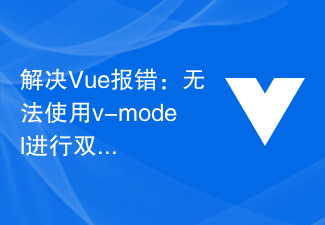![如何解决“[Vue warn]: v-model is not supported on”错误](https://img.php.cn/upload/article/000/465/014/169295815615783.jpg?x-oss-process=image/resize,p_40)
How to solve the "[Vue warn]: v-model is not supported on" error
During the development process using Vue, sometimes we may encounter an error Tip: "Vue warn: v-model is not supported on". This error message usually appears when using the v-model directive to bind elements, and it also reminds us that it may appear because we are trying to bind an unsupported element.
So, how should we solve this error when we encounter it? Below we will give some common scenarios and corresponding solutions.
- Bind custom components
When we use the v-model directive to bind a custom component, Vue will use the value of v-model as the "prop" and "input" of the component by default events are delivered. Therefore, we need to receive the value of v-model binding through "props" in the custom component, and manually trigger the "input" event in the component to achieve two-way binding.
The following is a sample code for a custom component:
<template>
<div>
<input :value="value" @input="updateValue($event.target.value)" />
</div>
</template>
<script>
export default {
props: ['value'],
methods: {
updateValue(value) {
this.$emit('input', value);
}
}
}
</script>In the above code, we receive the value bound by v-model through props and trigger it through the updateValue method input event to implement two-way binding.
- Binding native HTML elements
If we use v-model to bind native HTML elements, there is usually no problem. But when we try to bind some special elements, such as, , etc., the above error will occur.The reason for this error is that the v-model directive is actually syntax sugar, which is converted internally into a value attribute and an input event to achieve two-way binding. These special elements do not support value attributes and input events, so an error will be reported.
The solution to this problem is very simple. We only need to replace the v-model directive with: value and @input to bind the value attribute and input event respectively. The following is a sample code:
<template> <div> <span :value="content" @input="updateContent($event.target.value)"></span> </div> </template> <script> export default { data() { return { content: '' } }, methods: { updateContent(value) { this.content = value; } } } </script>In the above code, we use :value and @input to replace the v-model directive, so that the value attribute and input event of the special element can be correctly bound. Implement two-way binding.
Summary:
When we encounter the "[Vue warn]: v-model is not supported on" error, we must first clarify the cause of the error. If you are binding a custom component, you need to manually handle the value and event of v-model in the component; if you are binding a special element, you need to replace it with :value and @input to achieve two-way binding.I hope that through the introduction of this article, readers can better understand and solve this error, and can perform two-way binding operations more smoothly in Vue development.
The above is the detailed content of How to solve '[Vue warn]: v-model is not supported on' error. For more information, please follow other related articles on the PHP Chinese website!
 Vue中如何使用v-model.number实现输入框的数据类型转换Jun 11, 2023 am 08:54 AM
Vue中如何使用v-model.number实现输入框的数据类型转换Jun 11, 2023 am 08:54 AM在Vue中,v-model是用来实现双向绑定的一个重要指令,它可以让我们很方便地将用户输入的内容同步到Vue的data属性中。但是在一些情况下,我们需要对数据进行转换,比如将用户输入的字符串类型转换成数字类型,这时候就需要使用v-model的.number修饰符来实现。v-model.number的基本用法v-model.number是v-model的一个修
![如何解决“[Vue warn]: Failed to resolve component”错误](https://img.php.cn/upload/article/000/887/227/169294231071013.jpg) 如何解决“[Vue warn]: Failed to resolve component”错误Aug 25, 2023 pm 01:45 PM
如何解决“[Vue warn]: Failed to resolve component”错误Aug 25, 2023 pm 01:45 PM如何解决“[Vuewarn]:Failedtoresolvecomponent”错误当我们在使用Vue框架开发项目时,有时会遇到一个错误提示:[Vuewarn]:Failedtoresolvecomponent,这个错误提示通常是在使用组件时出现的。那么,出现这个错误的原因是什么呢?通常有以下几种情况:组件注册错误:我们在组件中使用了未注
 解决Vue报错:无法使用v-model进行双向数据绑定Aug 25, 2023 pm 04:49 PM
解决Vue报错:无法使用v-model进行双向数据绑定Aug 25, 2023 pm 04:49 PM解决Vue报错:无法使用v-model进行双向数据绑定在使用Vue进行开发时,经常会使用v-model指令来实现双向数据绑定,但有时候我们会遇到一个问题,就是在使用v-model时会报错,无法正确进行双向数据绑定。这可能是由于一些常见的错误导致的,下面我将介绍几种常见的情况以及相应的解决方法。组件的props属性未正确设置当我们在使用组件时,如果需要通过v-
 Vue报错:无法正确使用v-model进行双向数据绑定,如何解决?Aug 19, 2023 pm 08:46 PM
Vue报错:无法正确使用v-model进行双向数据绑定,如何解决?Aug 19, 2023 pm 08:46 PMVue报错:无法正确使用v-model进行双向数据绑定,如何解决?引言:在使用Vue进行开发时,双向数据绑定是一项非常常见且强大的功能。然而,有时候我们可能会遇到一个问题,就是当我们尝试使用v-model进行双向数据绑定时,却遭遇到了报错。本文将介绍该问题的原因以及解决方案,并通过代码示例来演示如何解决该问题。问题描述:当我们在Vue中尝试使用v-model
 如何解决Vue报错:无法正确使用v-model进行双向数据绑定Aug 25, 2023 pm 04:13 PM
如何解决Vue报错:无法正确使用v-model进行双向数据绑定Aug 25, 2023 pm 04:13 PM如何解决Vue报错:无法正确使用v-model进行双向数据绑定引言:Vue是一种流行的前端框架,它提供了许多方便的功能,其中包括v-model指令用于实现双向数据绑定。然而,有时候我们在使用v-model时可能会遇到一些错误,特别是在处理复杂的数据结构时。本文将介绍几种常见的v-model错误,并提供解决方案和代码示例。错误:v-model与对象属性的双向绑
 win11客户端和服务器不支持常用的sslDec 29, 2023 pm 02:09 PM
win11客户端和服务器不支持常用的sslDec 29, 2023 pm 02:09 PM如果客户端与服务器均未实现SSL加密技术,极易造成信息在传播过程中遭受中间攻击者的窃取,从而引发严重危害数据安全之隐患。为此,应紧急采取相应措施以有效保障敏感数据安全,可以参考下面的方法来进行操作。win11客户端和服务器不支持常用的ssl1、对服务器系统进行升级改造可以优先考虑对服务器系统进行升级与优化,或者补充所需的必要组件,以确保其能够顺利地支持最新的SSL协议。2、部署SSL证书您可以选购以及部署那些享有盛誉的认证中心发布的SSL证书,将其安装于服务器内即可实现此功能。3、开启SSL协议
 Vue中使用v-model的双向绑定优化应用的数据性能Jul 17, 2023 pm 07:57 PM
Vue中使用v-model的双向绑定优化应用的数据性能Jul 17, 2023 pm 07:57 PMVue中使用v-model的双向绑定优化应用的数据性能在Vue中,我们经常使用v-model指令来实现表单元素与数据之间的双向绑定。这种双向绑定的方式极大地简化了开发过程,并提高了用户体验。然而,由于v-model需要监听表单元素的input事件,当数据量较大时,这种双向绑定可能会带来一定的性能问题。本文将介绍如何优化使用v-model时的数据性能,并提供一
 实例详解Vue中v-model指令的用法Aug 10, 2022 pm 05:38 PM
实例详解Vue中v-model指令的用法Aug 10, 2022 pm 05:38 PMVue中可以使用v-model指令来实现数据双向绑定,下面本篇文章就来带大家了解一下v-model指令,希望对大家有所帮助!


Hot AI Tools

Undresser.AI Undress
AI-powered app for creating realistic nude photos

AI Clothes Remover
Online AI tool for removing clothes from photos.

Undress AI Tool
Undress images for free

Clothoff.io
AI clothes remover

AI Hentai Generator
Generate AI Hentai for free.

Hot Article

Hot Tools

Dreamweaver Mac version
Visual web development tools

SAP NetWeaver Server Adapter for Eclipse
Integrate Eclipse with SAP NetWeaver application server.

Atom editor mac version download
The most popular open source editor

VSCode Windows 64-bit Download
A free and powerful IDE editor launched by Microsoft

SublimeText3 Chinese version
Chinese version, very easy to use






